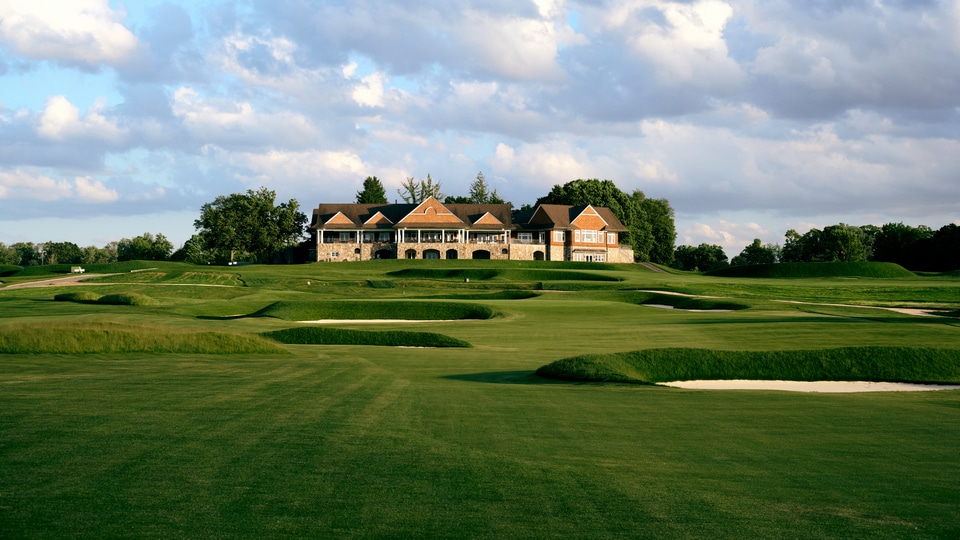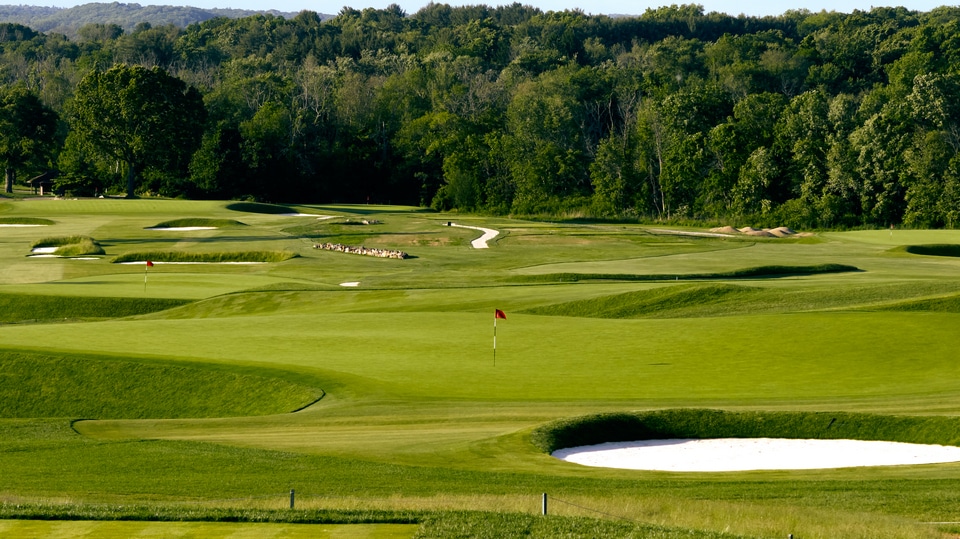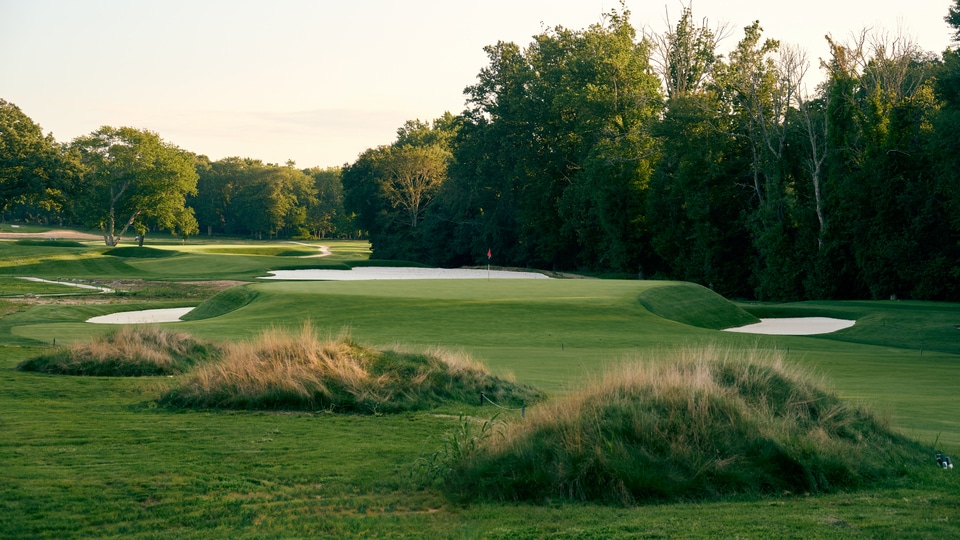TAMARACK CC
Greenwich, CT, USA
Architect: Charles “steam shovel” Banks (1929)
Most recent updating: Brian Schneider (2023)
Finicky rating: Birdie +
My intersection with Tamarack goes back 50 years when the club hosted the area qualifier for the US Junior Amateur. I had played one other Charles Banks course prior to my visit to Connecticut – the Banks Course at Forsgate in NJ – and was smitten with the design style one sees with any Banks layout.
Over the years Tamarack did change – but not for the better. The inane inclusion of trees and other clutter only obscured the inherent qualities of the course. Green sizes shrunk and the “look” of the course took on a more modern appearance than a clear link in concert with its classic architectural roots.
Smartly, the leadership brought in architect Brian Silva a few years back to assist with matters and his efforts helped. Even more was needed and the club wisely hired Brian Schneider of Renaissance Golf Design.

I returned to Tamarack just a few weeks ago and was more than impressed by the collective corrective actions implemented.
Schneider has carried out his assignment in an exemplary manner. First and foremost, the overall scale of the property can now be totally appreciated. The holes are not separated from one another by mindless tree insertions. Now you are marvelously treated to an engrossing visual dynamic. Gazing from the clubhouse out onto the property gets the blood going and the itch to play becomes overwhelming.
A Banks course is one where boldness and big features need to be fully visible and not hidden. That openness of the property has now been wonderfully resurrected.
The general routing for Tamarack follows a south/north and north/south direction with two major exceptions. The par-3 3rd heads westerly and the finale moves in an easterly direction. Fascinating, how both holes are located side-by-side to one another.

Individual holes weave about in a varying manner with only limited sameness in a general direction. The 13th and 14th and then the 16th and 17th are examples of that.
As with any Banks course – the size of the greens plays a critical role. Tamarack has large greens – often in excess of 10,000 square feet. The internal contours are vexing because of devilishly subtle movements which are extremely difficult to decipher save for those players having played numerous times.
Tamarack requires a deft iron play with one’s approaches. If you happen to be consistently facing longish putts you will find the task producing mounting headaches and likely incur three-putts on a regular basis. Within the footprint of the greens is often different sub-sections so it’s imperative to get to those positions on one’s approach shots.
Pin placements can be quite challenging, especially when placed in the corners. Players seeking to land near such areas had best be mindful of what they must do from an execution standpoint. Failure will most certainly mean scorecard pain.

Compelling architecture only flourishes when turf preparation is carried out with total details included. Tamarack is fortunate in having veteran superintendent Jeff Scott at the helm. One of the very first things you notice when playing is the absence of overly moist turf. Scott is a believer in keeping playing conditions as firm and fast as possible. This approach keeps the bounce of the ball in the equation for all levels of players and makes strategic decisions even more challenging.
The other pivotal dimension is the keen maintenance practices employed so that core architectural elements are brought to full life and meaning. You see that most especially through the turf presentation manifesting in the swiftness and utter smoothness of the devilish putting surfaces. Credit Scott and his hard-working team in keeping speeds within reason so all key important pin positions are maintained.
During my visit I also saw the desire to “recharge” native fescue grasses within different parts of the property. When that happens in 2025 the juxtaposition of the mown areas in contrast to the flanking native grasses will only add to the visual character to the property.
Tamarack grabs your attention right from the outset. The first four holes provide individual diversity via collective strength. The opening hole forces players to deal with a center-placed fairway bunker adroitly positioned. I am reluctant to use the word “great” because it is applied too liberally but in the metro New York area I rate the opener at Tamarack with the best of them.

The 2nd was vastly improved by Schneider and players have to negotiate a series of artfully placed fairway bunkers. The tee box was extended and lowered. And the approach is no less challenging with a false front that must be successfully negotiated.
The 3rd mandates a deft play with a short iron. The green is quite large but as previously outlined, there are different sections and failure to be in the right place will mean an arduous two-putt.
The 4th is a strong two-shot hole with menacing fairway bunkers lurking for those who get careless off the tee.
The 5th is the longest hole at Tamarack and when played into the prevailing south / southwest wind can be a chore. The uphill 6th beautifully uses the landscape in climbing uphill.

Related: Louisville lives
One of the real pluses Schneider provided comes with the bolstering of the Redan hole at the par-3 7th. The previous version was simply ordinary and the one now has been strengthened to play more as a legitimate Redan. Tamarack’s 7th is not on the same page with such luminaries as the 4th at National Golf Links of America or the 2nd at Somerset Hills, but the added length and the manner by which the right-hand shoulder was crafted now places a far-higher premium on flighting one’s golf ball with utmost skill.
The only clear downside at Tamarack comes with the stretch of holes commencing with the par-4 8th. Each is fairly ordinary and lacks the heft to the ones preceding and following.
Fortunately, matters change when reaching the 11th. Named “punchbowl” the par-4 is done well and concludes with a green that commands a variety of different approach shots for players to consider.

The 12th is one of the real highlights. The re-creation of a Biarritz hole is often attempted but rarely succeeds. The par-3 is helped with a longish green – just under 80 yards and the flanking bunkers play a key role. The one on the left drops down 15 feet from the green’s surface and has to be avoided. The one on the right is easier in terms of challenge but hardly elementary. An interesting aspect is how the cart path is placed brilliantly inside the rear edge of the right bunker in order to provide access.
The 13th and 14th provide two challenging long par-4 holes. Both go in the same direction with the former moving downhill with a superb green that offers three distinct zones. The former is flattish but protected on the approach with wetlands right and a large donut bunker hugging closely to the left.
The concluding four holes are a quality mixture of varying lengths and requirements. The par-3 15th is short on distance but the need for a jeweler-like touch on the approach is essential.

Another highlight comes with the “new” 16th. The previous short par-4 hole was lame — pedestrian in its requirements. Schneider smartly added bunkers and elevated the green site. Players have to successfully maneuver the tee shot into the proper position. The presence of the green also dovetails with the Banks style. Birdies are possible – so are bogeys for those asleep on execution.
The penultimate hole provides the last really good birdie opportunity. The drive needs to move slightly on a left-to-right ball flight. Strong players can get to the green in two shots but once again a false front awaits those not able to get beyond the leading front edge.
The only downside is that both the 5th and 17th parallel one another and follow a similar direction, albeit with vastly different total lengths.

The concluding hole is a real tiger not easily tamed and possessing sharp claws. The 469-yard hole moves uphill with a series of bunkers awaiting on both sides in the fairway. Those driving to the center/right of the fairway will face a blind second shot. Those driving to the far left of the fairway may catch a glimpse if long enough up the hill.
The green is perilous and needs to be approached carefully. The putting surface tilts in a big-time manner from right-to-left. Should you miss on the right side and the pin is placed on that same side your last name had best be Ballesteros if you plan on securing a par.
Where does Tamarack rate in the Nutmeg State? For years Yale has been conceded the top spot but the New Haven club is now undergoing massive updating by Gil Hanse. For me, the jury is out for now until the finished product can be thoroughly examined.

So where is the competition?
The leading candidate for the top spot now is Wee Burn. The Darien club successfully hosted this year’s Met Open and is one of the most underrated Devereux Emmet designs.
Tamarack secures the runner-up spot given the comprehensive nature of the work done. A number of clubs are seeking to improve themselves. Doing it properly and smartly can be a tricky road to navigate.
Kudos to the club leadership in hiring such talented individuals and letting them do what they do best.
Architectural connoisseurs should check it out if time and circumstances permit. You will not be disappointed.
Ratings AssessmentDouble Eagle — Not a hole to be missed. Compelling architecture throughout testing mental and physical resolve. Your heart bumps with exhilaration from 1st tee to 18th green. Eagle + — Superior shotmaking values in tandem with related turf quality melding an experience of the highest order. Eagle — Like its namesake – flies high in the clouds. Consistent variety with strategic holes demonstrating brilliance at various moments. Birdie + — Engaging design providing thoughtful intersections with creative results front and center. Birdie — Quality architecture exists but held back by limited standout holes encountered. Par+ — Has several holes of note but too many pedestrian ones subtract from the experience. Par — Enjoyable but like vanilla ice cream – mainly ordinary. Bogey — Little substance of note – has design fumbles that are more prevalent than need be. Double-bogey — A total mistake — in need of upgrades with substandard holes, inferior routing and substandard conditioning. Triple-bogey — An utter mess. Avoid the pain of the experience and the loss of time / money. ***
|

For the latest news in the golfing world, follow us on X.
